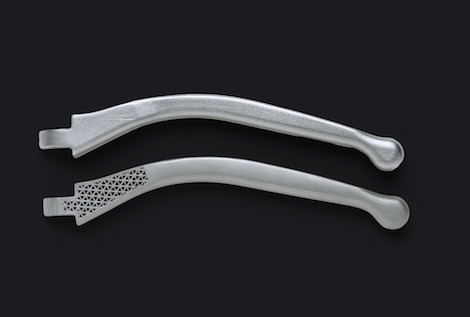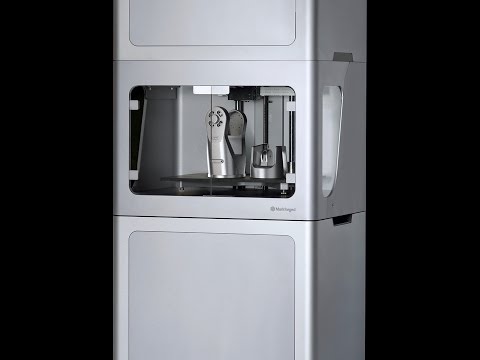//giphy.com/embed/vjQkZUNeerQru
Hot on the heals of the Mark Two, the Mark X and Onyx One announcements, which saw Markforged line up both the entry level and top end of its plastics product line, comes the launch of the Metal X.
The launch at CES in Las Vegas sees a departure from its business to date, which has focused on printing with carbon fibre (both in chopped form and continuous) mixed with a nylon matrix material to tackle one of the most hotly tipped areas for 3D print – metal.
The machine centres on a process that Markforged have dubbed Atomic Diffusion Additive Manufacturing (ADAM). Let’s dig into that a little deeper.
Markforged processes focus on the laying down of filament, as per every other filament machine on the planet. The machine lays out the filament layer by layer, with varying degrees of solidity (user controls), until the final form of the part is reached.
What ADAM brings to this is a plastic material that’s mixed with metal powder. That combination of plastic and metal powder means that you have a solid part, that contains metal powder held in its solid form.
That part is then baked in an oven to the required temperature, so that the metallic powder particles fuse together and the plastic burns off, leaving a near dense part.
For those with a keen eye for manufacturing processes, you’ll be aware that this is the same process that happens in sintering.
Sintering, for the uninitiated, is a term that’s come to be commonly associated in the tech world with laser sintering of material to build 3D prints in a variety of materials. But it’s roots lie much, much earlier (like, REALLY earlier).
Sintering is what happens when you part bake ceramic in a kiln to create a plate, a pot or anything else and that has been happening for millennia.
What Markforged has built is a machine that combines its expertise in filament based processing of materials with some smart research into where this could lead.
Once your part is built in the Metal X, it’s in its green state. The metallic particles are held within the plastic material in their required form.
This green model is then baked in an industrial oven, the plastic burns out, the metal particles fuse together (sintering is done at just below the melting point of the material) and you’re left with a part that’s geometrically the same, but smaller (in this instance, around the 25% mark).
So, working backwards, scale up your part by the required factor, build it in the Metal X, move to an industrial oven and a couple of hours later, you’ve got a metal part that’s 85% to 90% dense to the size you want.

ADAM vs Laser Sinterers
Metals production using layer-based approaches is a big-ticket item for many, particularly given some of the freedoms it presents in terms of design complexity (but by no means removes all of the “design for manufacture rules”). What’s interesting is that the Metal X’s ADAM process offers a different take on the traditional metal sintering processes – and those differences are found in a couple of different areas.
The first, and this is huge, is that at no point are you handling raw metallic powder. Powder Metal is the stuff of health and safety nightmare – file under “things that makes you go boom”. Any powdered material is explosive under the right/wrong conditions, metal powder, doubley so.
Machines that require it have some pretty extensive safety precautions and ancillary equipment, from filtration systems to industrial vacuums that looks more Death Star than Henry the Hoover and its part of the reason that metals machines are so costly – you’re essentially containing a large explosion waiting to happen with stainless steel and inert gases.
With the ADAM process, Markforged are side stepping this entirely, reducing the cost of adoption and maintenance dramatically.
There’s also an issue in terms of how parts are built in a typically laser sinterer. Because machines like those from EOS or 3D systems use a laser spot to build up each layer in a powder bed, there are inherent thermal stresses built into the part from the word go.
These can, if not understood, predicted and accounted for, mean a deformed part or certainly one that requires post treatment to bring it into tolerance. I could add a Creeping Death reference here, but I’ll resist.
This is one of the reasons that research into predicting these effects is causing such interest (see Autodesk’s acquisition of Pan Computing’s technology recently). With the ADAM process, this is side stepped because the parts are built in a green state without any heat above that required to bind the plastic together.
The machine itself

The Metal X follows the same form factor as the high-end Mark X, but with additional works at both the bottom and the top of the machine (hence it’s triple height form). The build volume is 250mm x 220mm x 200mm – remember, you’ll need to account for upscaling.
It includes the bells and whistles of the Mark X, including laser-based in process inspection, and adds in a new cloud-enabled build camera.
In terms of materials, the machine is launching with stainless steels such as 17-4 and 303, but as you’d expect, the company is looking to expand this.
If you buy into the process, owners will be able to participate in the Metal Materials Beta program, which will extending the metal options to include Tool Steel (A-2, D-2, M-2), Aluminium (6061, 7075), and Titanium (6AL 4V).
In terms of pricing, the machine starts at $99,500 and is available to order now, shipping in September. That price doesn’t include an industrial oven to bake the parts, but these are commodity items, so there’s a huge range available on the commercial market, ranging from five grand upwards or so.
With the launch of this, Markforged has a pretty nice product range, from entry level nylon+chopped carbon with the Onyx One and the mid-range with the Mark Two which brings continuous carbon fibre to the mix. The high-end, industrial grade Mark X adds a bigger build volume, so some might wonder how to choose between plastics and metals.
To help you out a little bit, the team has a bundle that includes the Mark X and the Metal X for $149,000.
To quote Markforged’s CEO, Greg Mark: “If you can afford a half million to a million dollar metal printer, buy one. For the rest of the world, this is for you”. Couldn’t have put it better myself, even if I would have chosen a better song for the launch video. To make up for things, here’s Motörhead.






